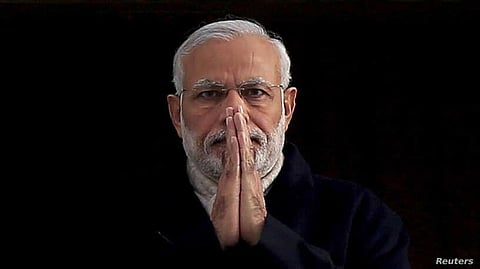
- Home
- न्यूजग्राम
- NewsGram USA
- India
- World
- Politics
- Entertainment
- Culture
- Lifestyle
- Economy
- Sports
- Sp. Coverage
- Misc.
- NewsGram Exclusive
- Jobs / Internships

By Anjana Pasricha
India prides itself on popularizing yoga and meditation in many parts of the world. Now it is watching to see if the country's traditional greeting, the namaste, described as "virus-proof," goes global as some world leaders adopt it amid the coronavirus pandemic.
As health authorities advise people to avoid shaking hands to curb the spread of the highly contagious coronavirus, U.S. President Donald Trump, French President Emmanuel Macron, and Britain's Prince Charles this week used something resembling the Indian greeting, which involves welcoming a guest with palms pressed together.
"Namaste," a combination of two Sanskrit words, translates into "bowing to you" and does not involve skin contact and allows people to maintain a distance.
Queen Letizia of Spain (2nd R) and King Felipe VI of Spain (R) are welcomed by French President's wife Brigitte Macron (L) and France's President Emmanuel Macron before a lunch at the Elysee presidential Palace in Paris on March 11, 2020. VOA
Macron folded his palms in the traditional Indian manner and bowed slightly while greeting Spain's King Felipe and Queen Letizia at the Elysee Palace in Paris earlier this week.
The French ambassador to New Delhi, Emmanuel Lenain, tweeted, "President Macron has decided to greet all his counterparts with a namaste, a graceful gesture that he has retained from his India visit in 2018."
When Trump was asked by reporters how he greeted the Irish Prime Minister Leo Varadkar during their meeting in Washington Thursday, both leaders put their hands together to demonstrate what they did.
"I just got back from India. And I did not shake any hands there, and it was very easy because they go like this and Japan goes like this," Trump said doing a quick demonstration of the Indian namaste and the Japanese ojigi — bowing.
President Donald Trump and Irish Prime Minister Leo Varadkar joke about not shaking hands during a meeting and use the "namaste" greeting in the Oval Office of the White House. VOA
"They are ahead of the curve," he said.
Of course, it is not easy to forego the customary handshake, the usual photo opportunity in the halls of power that is often carefully watched to see how long or warm it is.
Trump said "we looked at each other and said what are we going to do? Sort of a weird feeling."
"It almost feels impersonal. It feels like you're being rude," Varadkar said. "But we just can't afford to think like that for the next few weeks."
In Britain, Prince Charles, the heir to the throne, also used the namaste-style greeting instead of a handshake as he met guests at a London event.
Again, replacing the deeply ingrained habit was not easy.
A video shows him putting his hand forward to greet Sir Kenneth Olisa, the lord lieutenant of Greater London, Queen Elizabeth's representative in Greater London, and then quickly withdrawing it and folding his hands instead.
Britain's Prince Charles and Camilla, Duchess of Cornwall attend the Commonwealth Reception at Marlborough House, in London, Britain. VOA
"It's just so hard to remember not to," he is reported to have said.
Last week, Israeli Prime Minister Benjamin Netanyahu advocated the Indian-style greeting to his country and went on to demonstrate it by folding his hands at a press conference.
In India, too, where handshakes and hugs have become popular, especially in cities, Prime Minister Narendra Modi reminded the country of the benefits of sticking to the traditional greeting.
Saying that the world is picking up the habit, he advised citizens who had junked the namaste that this is the right time to revert to it.
Most people are heeding the advice amid mounting fears of the spread of the coronavirus. (VOA)
